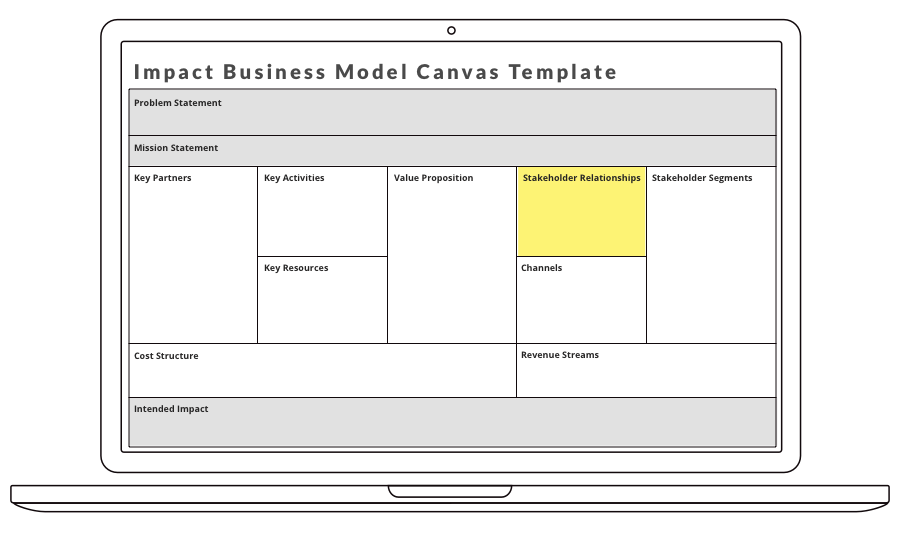
6 | Stakeholder Relationships

Stakeholder Relationships highlighted on the canvas
A company should clarify the type of relationship it wants to establish with each customer segment. Customer relationships may be driven by the motivation to acquire customers, retain customers and/or boost sales. We can distinguish between several categories of relationships, which may co-exist in a company’s relationship with a particular customer segment: personal assistance, dedicated personal assistance, self-service, automated service, communities, and co-creation.
In social enterprises customer relationships are critical. Customers may be attracted to our value proposition just from a purely business perspective, and we should aim to retain their custom on this basis. However, some may ‘fall in love’ with us as a social enterprise once they learn of the ‘added value’ our social impact brings to the exchange. Think through what role your impact should play in the relationship you have with your customers ... [continued below]
Stakeholder relationships:
d.light sells solar energy solutions to populations without electricity in 60+ nations. See project description and its Impact BMC
Stakeholder relationships:
EOS team provides direct assistance through consulting [b]
EOS team co-creates action plans with school leadership [b]
Impact reporting and sharing of learning and best practices with partners [b]
Equal Opportunity Schools helps minority and low-income high school students succeed in AP and IB courses. See project description and its Impact BMC
Sometimes it is important for the impact to be very present in the relationship and in other circumstances it would be inappropriate for your mission to form any part of the relationship. There are exciting design possibilities up for exploration here and opportunities to reposition customers as change agents for your cause!
Social enterprises evolve in a vast ecosystem and can be creative in the way they design their relationships with the recipients of the social value they aim to create, supporters (individual donors, foundations, impact investors) who make it possible, employees and volunteers who deliver it, and regulators who enable it.
At a minimum responsible businesses are concerned with avoiding any negative impact of their activities on the organization’s stakeholders. To that effect, they engage in responsible waste management, design humane labor working conditions, partake in responsible R&D practices,… etc.
The organization may focus on proactively delivering impact for one or more of the venture’s stakeholders. Recipients of free or heavily sponsored products or services benefit when those align with an unsatisfied need. Employees may benefit through the recruiting of underemployed populations, benefits & compensation policies, professional development programs, or employee engagement initiatives. Suppliers may benefit through fair sourcing practices, industry wide coordination of standards,…etc. Local communities may benefit through job generation, inclusion programs, sponsorship of community activities, employee volunteerism, proactive environmental preservation or restoration, and more.
Ex:
According to the 2013 State of the American Workplace by Gallup, 70 percent of American employees are disengaged, unenthusiastic, or not committed to their work. With many nonprofits working at the edge of their capacity, the focus on resource maximization is critical. How do we maximize the potential of our employees—our most valuable assets? By focusing on culture.